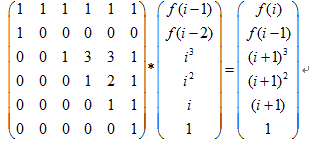又见斐波那契
Time Limit: 2000/1000 MS(Java/Others) Memory Limit: 65536/32768 K (Java/Others)
Problem Description
这是一个加强版的斐波那契数列。
给定递推式
求F(n)的值,由于这个值可能太大,请对109+7取模。
Input
第一行是一个整数T(1 ≤ T ≤ 1000),表示样例的个数。
以后每个样例一行,是一个整数n(1 ≤ n ≤ 1018)。
Output
每个样例输出一行,一个整数,表示F(n) mod 1000000007。
Sample Input
4
1
2
3
100
Sample Output
1
16
57
558616258
【题目链接】 link
【思路】
由于n很大,还是自然地想到矩阵快速幂,但关键是矩阵的构造问题。
根据题目的表达式,我们主要要寻找的就是几个常数之间的关系。
推算得到:
(i+1)3=i3+3i2+3i+1
(i+1)2=i2+2i+1
i+1=i+1
那么就可以构造矩阵了
有了矩阵后直接套模板即可
#include <cstdio>
#include <bits/stdc++.h>
#include <cmath>
#include <map>
#include <iostream>
#include <cstring>
#include <algorithm>
using namespace std;
#define mst(a,b) memset((a),(b),sizeof(a))
#define rush() int T;scanf("%d",&T);while(T--)
typedef long long ll;
const int maxn = 6;
const ll mod = 1e9+7;
const int INF = 1e9;
const double eps = 1e-6;
struct Matrix
{
ll temp[maxn][maxn];
} a;
void init()
{
for(int i=0;i<6;i++)
for(int j=0;j<6;j++)
{
a.temp[i][j]=0;
}
for(int i=0;i<6;i++) a.temp[0][i]=1;
a.temp[1][0]=1;
a.temp[2][2]=a.temp[2][5]=1;
a.temp[2][3]=a.temp[2][4]=3;
a.temp[3][3]=a.temp[3][5]=1;
a.temp[3][4]=2;
a.temp[4][4]=a.temp[4][5]=1;
a.temp[5][5]=1;
}
Matrix mul(Matrix a,Matrix b)
{
Matrix ans;
for (int i=0; i<maxn; i++)
for (int j=0; j<maxn; j++)
{
ans.temp[i][j]=0;
for (int k=0; k<maxn; k++)
{
ans.temp[i][j]+=(a.temp[i][k]*b.temp[k][j]+mod)%mod; //特别注意
ans.temp[i][j]%=mod;
}
}
return ans;
}
void fun(Matrix ans,ll k)
{
for(int i=0; i<maxn; i++)
for(int j=0; j<maxn; j++)
a.temp[i][j]=(i==j);
while(k)
{
if(k%2)
a=mul(a,ans);
ans=mul(ans,ans);
k/=2;
}
}
int main()
{
Matrix t;
ll n;
for(int i=0;i<maxn;i++)
for(int j=0;j<maxn;j++)
{
t.temp[i][j]=0;
}
t.temp[0][0]=1;
t.temp[2][0]=8;
t.temp[3][0]=4;
t.temp[4][0]=2;
t.temp[5][0]=1;
rush()
{
scanf("%lld",&n);
init();
if(n<=1)
{
printf("%lld\n",n);
continue;
}
fun(a,n-1);
a=mul(a,t);
printf("%lld\n",a.temp[0][0]);
}
return 0;
}

